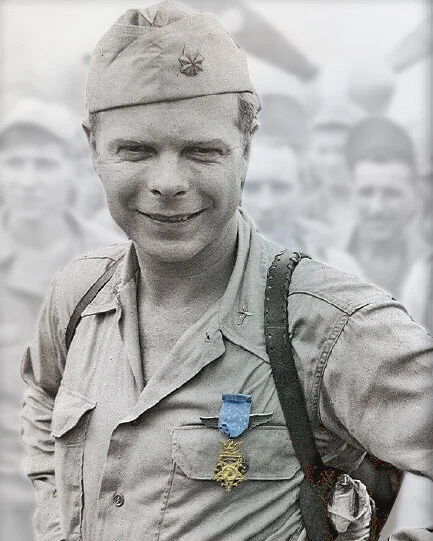Richard I Bong
On the 24th of September, 1920, in Superior, Wisconsin, Richard was born as the first of nine children. He grew up on a farm in Poplar, Wisconsin, and became interested in airplanes at a very young age. Planes used to fly over his farm when they were taking mail to President Coolidge's Summer White House in Superior and Richard also took to building model planes. Once he entered high school, he played baseball, basketball, hockey, and played the clarinet in the marching band. Richard transferred from Poplar High School, which was a three year school at the time, to Central High School in Superior for his senior year and graduated in 1938. After high school, he attended what is now the University of Wisconsin-Superior (Superior State Teachers College at the time) and also enrolled in the Civilian Pilot Training Program while taking private flying lessons. Richard furthered his passion for flying by enlisting in the Army Air Corps Aviation Cadet Program on the 29th of May, 1941.
Richard completed his training and was commissioned as a Second Lieutenant on the 19th of January, 1942, along with receiving his pilot wings. He then was a gunnery instructor at Luke Field in Arizona until May of that year before being assigned to the 49th Fighter Squadron, 14th Fighter Group at Hamilton Field in California. It was here that he and three other pilots were temporarily grounded for breaking flying rules. Richard had flew extremely low and buzzed over a house of a pilot that had just been married. The other pilots had flown at a low level down Market Street in San Francisco and looped around the Golden Gate Bridge. Richard denied flying under the bridge but he was still grounded while the rest of his group deployed to England in July of 1942. He was then transferred to the 84th Fighter Squadron, 78th Fighter Group and deployed to the South Pacific.
Richard was assigned to the 9th Fighter Squadron while at Darwin, Australia, and was flying P-40 Warhawks. He was temporarily reassigned to fly missions in order to gain combat experience and he claimed his first aerial victory when he shot down a Mitsubishi A6M Zero and a Nakajima Ki-43 Oscar on the 27th of December, 1942, during the Battle of Buna-Gona. Richard received the Silver Star for his actions and then rejoined the 9th Fighter Squadron. In April of 1943, Richard was promoted to First Lieutenant, claimed four Japanese fighters in July for which he received the Distinguished Service Cross, and was promoted to Captain in August of that same year. Three months later, he was on leave back in the States and met Marjorie Vattendahl at their college's homecoming event and the two began dating. When Richard returned to the Pacific in January of 1944, he named his P-38 “Marge” and put her photo on the nose of the plane. Three months later, on the 12th of April, he surpassed Eddie Rickenbacker's record of 26 air victories during World War 1 when he shot down his 26th and 27th Japanese aircrafts. Richard was promoted to Major soon after and was sent on leave back to the States. He visited training bases and went on a fifteen state war bond tour, after which he returned to the South Pacific in September. Richard became an advanced gunnery instructor that was to go on missions but was to not seek combat. Ironically, he thought his own gunnery accuracy was poor and when he did engage an enemy aircraft, he would get as close as possible in order to make sure that he would hit them. His actions during the Philippines Campaign, specifically during his time as an instructor, that would earn him the Medal of Honor. The citation reads:
For conspicuous gallantry and intrepidity in action above and beyond the call of duty in the Southwest Pacific area from October 10, to November 15, 1944. Though assigned to duty as gunnery instructor and neither required nor expected to perform combat duty, Maj. Bong voluntarily and at his own urgent request engaged in repeated combat missions, including unusually hazardous sorties over Balikpapan, Borneo, and in the Leyte area of the Philippines. His aggressiveness and daring resulted in his shooting down 8 enemy airplanes during this period.
By December 17th, Richard had forty air-to-air victories. He received his Medal of Honor in a special ceremony from General MacArthur and the following month, he was sent home by General Kenney, commander of the Far East Air Force. Richard married Marjorie on the 10th of February, 1945, and even though he wasn't flying missions in the South Pacific, he was still participating in many public relations activities for the military and promoting war bonds.
Richard was assigned to the Lockheed Corporation and he went to their Burbank, California plant to be a test pilot. Here he flew their P-80 Shooting Star jet fighters and had acquired four hours and fifteen minutes of flight time, which was twelve flights. His final flight, however, was on the 6th of August, 1945, when the primary fuel pump malfunctioned during take off and he was too low for his parachute to deploy. Richard was a month away from his 25th birthday when he died and the news of his death shared the front page news with the atomic bombing of Hiroshima. Richard Ira Bong is buried in the Poplar Cemetery in Poplar, Wisconsin: Plat I, Block 8, Lot 10, Grave 2.




